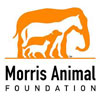-
Ackerman L. The Genetic Connection. AAHA Press, Lakewood CO, 1999.
-
Bardens JW. Palpation for the detection of dysplasia and wedge technique for pelvic radiography. Proc AAHA; pp 468-471, 1972.
-
Belkoff SM, et al. Development of a device to measure canine coxofemoral joint laxity. VCOT, Vol 1: 32-36, 1989.
-
Bennett D. Hip Dysplasia and Ascorbate Therapy: Fact or Fancy? Seminars in Vet. Med. And Surg., Vol. 2, No. 2, 1987, p. 152-1 57.
-
Berry CR. Evaluation of the canine elbow for fragmented medial coronoid process. Vet. Radiol. & Ultrasound, 1992:33(5): 273-276.
-
Canine Hip Dysplasia Symposium. Workshop Panel Reports: St. Louis, MO 1972.
-
Carpenter LG, Schwarz PD, Lowry JE, Park RD, Steyn PF. Comparison of radiographic imaging techniques for diagnosis of fragmented medial coronoid process of the cubital joint in dogs. J Am Vet Med Assoc, Vol 203, No 1, July 1, 1993.
-
Corley EA. Role of the Orthopaedic Foundation for Animals in the control of canine hip dysplasia. Vet Clin of N America Sm Anim Prac 1992;22(3):579-593.
-
Corley, EA, et al. Reliability of early radiographic evaluation for canine hip dysplasia obtained from the standard ventrodorsal radiographic projection. JAVMA. Vol 211, No. 9, November 1997
-
Corley EA, Carlson W. Radiographic, genetic, and pathologic aspects of elbow dysplasia. J Am Vet Med Assoc, 1965;147:1651.
-
Corley EA, Hogan PM. Trends in hip dysplasia control: Analysis of radiographs submitted to the Orthopedic Foundation for Animals, Inc., 1974 to 1984. JAVMA, Vol 187: 805-809, 1985.
-
Dixon RT. The effect of limb positioning on the radiographic diagnosis of canine hip dysplasia. Vet. Rec., Vol 91: 644-646, 1972.
-
Farese JP, Lust G, Williams AJ, Dykes NL, Todhunter RJ. Comparison of measurements of dorsolateral subluxation of the femoral head and maximal passive laxity for evaluation of the coxofemoral joint in dogs. AJVR 1999;60(12):1571-1576.
-
Grondalen J. Arthrosis in the elbow joint of young, rapidly growing dogs: Interrelation between clinical radiological, and pathoanatomical findings. Nordish Veterinarmedicin, 1982; 34:65-75.
-
Grondalen J, Grondalen T. Arthrosis in the elbow joint of young, rapidly growing dogs. Nordish Veterinarmedicin, 1981:33:1-16.
-
Guthrie S, Pidduck HG. Heritability of elbow osteochondrosis within a closed population of dogs. J. Sm. Anim. Pract., 1990: 31: 93-96.
-
Hedhammar A. Breeding healthier dogs in Sweden. Tijdschrift voor Diergeneeskunde 1991;116(11):76s-79s.
-
Hedhammer A, Olsson SE, et al. Study of Heritability in 401 Litters of German Shepherd Dogs. JAVMA, Vol. 1974; 1012-1016, 1979.
-
Henry JD, Park RD. Wedge technique for demonstration of coxofemoral joint laxity in the canine. Proc. Canine Hip Dysplasia Symposium and Workshop; OFA, Columbia, MO, p. 117-126, 1972.
-
Jessen CR, Spurrell FA. Radiographic detection of canine hip dysplasia in known age groups. Proceedings of the Canine Hip Dysplasia Symposium and Workshop. 1972;Oct 19-20, St. Louis, MO.
-
Kaneene JB, Mostosky UV, Padgett GA. A retrospective cohort study of canine hip dysplasia in the United States. J Am Vet Med Assoc 1997;211(12):1542-1544.
-
Kasstrom H. Nutrition, weight gain, and development of hip dysplasia: An experimental investigation in growing dogs with special reference to the effect of feeding intensity. Acta Radiol. Suppl., Vol 344: 135-179, 1975.
-
Kealy RD, et al. Effects of limited food consumption on the incidence of hip dysplasia in growing dogs. JAVMA, Vol. 201,No. 6, 1992, p.857-863.
-
Kealy RD, et al. Effect of diet restriction on life span and age-related changes in dogs. JAVMA, 2002; 220: p.1315-1320.
-
Keller GG, Corley EA. Canine hip dysplasia: Investigating the sex predilection and the frequency of unilateral canine hip dysplasia. Veterinary Medicine 1989;Dec:1162-1166.
-
Keller GG, Dziuk E, Bell, JS. How the Orthopedic Foundation for Animals (OFA) is tackling inherited disordersin the USA: Using hip and elbow dysplasia as examples. The Veterinary Journal 189 (2011) 197–202.
-
Keller GG et al. Corollation of radiographic, necropsy and histologic findings in 8 dogs with elbow dysplasia. Vet Rad and US, 1997; 38:(4):272-276.
-
Keller GG et al. Influence of the estrous cycle on coxofemoral joint subluxation. Canine Practice 1993;18:(1):19-22.
-
Keller GG, Reed AL, Lattimer JC, Corley EA. Hip dysplasia: A feline population study. Vet Rad and US 1999;40(4):460-463.
-
Keller GG, Vogt D, Corley EA, Ellersieck M. Progress in the control of hip dysplasia: The Portuguese Water Dog as a model. American Kennel Club Gazette 1991;Nov:55-58.
-
Larsen JS. Lumbosacral transitional vertebrae in the dog. J Amer. Vet. Soc., Vol. 18, No. 3, 1977, pp. 76-79.
-
Leighton EA. Genetics of canine hip dysplasia. J Am Vet Med Assoc 1997;210:1474-1479.
-
Lust G. Overview of the pathogenesis of canine hip dysplasia. JAVMA, Vol. 210, No. 10, 1997, pp. 1443-1445.
-
Lust G et al. Joint laxity and its association with hip dysplasia in labrador retrievers. AJVR, Vol. 54, No. 12, 1993, p.1990-1999.
-
Lust, G et al. Comparison of three radiographic methods for diagnosis of hip dysplasia in eight-month old dogs. JAVMA, 2001; 219: p.1242-1246.
-
Lust G, Rendano VT, Simmons BA. Canine hip dysplasia: Concepts and diagnosis. J Am Vet Med Assoc 1985;187(6):638-640.
-
Mackenzie SA. Canine hip dysplasia: Why heritability estimates differ. Canine Pract., Vol 12: 19-22, 1985.
-
Merton DA. Selective breeding in the dog and cat: Part 1. Fundamentals of inheritance and planned breeding. Comp. Cont. Educ., Vol. 4(3), March 1982, pp. 251-258.
-
Morgan JP. Hereditary bone and joint diseases in the dog: Osteochondroses, hip dysplasia, elbow dysplasia. Hannover: Schultersche. 2000;183.
-
Morgan JP, Wind A, Davidson AP. Bone dysplasias in the Labrador Retriever: A radiographic study. JAAHA 1999;35:332-340.
-
Olsson SE. Osteochondrosis in domestic animals. ACTA Radiologic Suppl., 358, 1978, pp.299-305.
-
Olsson SE.The early diagnosis of fragmented coronoid process and osteochondritis dissecans of the canine elbow joint. JAAHA, 1983:19(5):616-626.
-
Padgett GA. Control of Canine Genetic Diseases. Howell Book House, New York, NY. 1998.
-
Padgett GA, Mostosky UV, Probst CW, Thomas MW, Krecke CF. The inheritance of osteochondritis dessicans and fragmented coronoid process of the elbow joint in Labrador Retrievers. JAAHA 1995;31:327-330.
-
Read RA, et al. Fragmentation of the medical coronoid process of the ulna in dogs: A study of 109 cases. J. Sm. Anim. Prac., 1990; 32(7), 330-334.
-
Reed AL, Keller G et al. Effect of dam and sire qualitative hip conformation scores on progeny hip conformation. JAVMA, 2000;217:675-680.
-
Rendano VT, Ryan G. Canine hip dysplasia evaluation. J Vet Radiol., Vol 26: 170-186, 1985.
-
Rettenmaier JL, Keller G, et al. Prevalence of canine hip dysplasia in a veterinary teaching hospital population. Vet Rad and US, 2002;43(4): 313-318.
-
Riser WH. Canine hip dysplasia: Cause and control. JAVMA, Vol. 165, No. 4, 1974, pp. 360-362.
-
Riser WH. The dog as a model for the study of hip dysplasia: Growth form and development of the normal and dysplastic hip joint. Vet Pathol 1975;12(4):234-334.
-
Robins GM. Some aspects of the radiographical examination of the canine elbow joint. J. Sm. Anim. Pract., 1980;21:417-428.
-
Smith GK. Advances in diagnosing canine hip dysplasia. JAVMA 1997;210(10):1451-1456.
-
Smith GK, Gregor TP, Gregor BS, Rhodes H, Biery DN. Coxofemoral laxity from distraction radiography and its contemporaneous and prospective correlation with laxity, subjective score, and evidence of degenerative joint disease from conventional hip-extended radiography in dogs. Am J Vet Res 1993;54(7):1021-1042.
-
Swenson L, Audell L, Hedhammar A. Prevalence and inheritance of and selection for elbow arthrosis in Bernese Mountain Dogs and Rottweilers in Sweden and benefit:cost analysis of a screening and control program. JAVMA, 1997; 210: 215 – 221.
-
Swenson L, Aurdell L, Hedhammar A. Prevalence and inheritance of, and selection for hip dysplasia in seven breeds of dogs in Sweden and benefit:cost analysis of a screening and control program. J Am Vet Med Assoc 1997;210:207-214.
-
Tomlinson JL, Johnson JC. Quantification of measurement of femoral head coverage and Norberg angle within and among four breeds of dogs. AJVR 2000;61(12):1492-1500.
-
Vogt D, Keller GG, Corley EA. Control of canine hip dysplasia: Using the Chinese Shar Pei as a model. The Barker 1995;2:47-49.
-
Willis MB. Practical Genetics for Dog Breeders. Great Britain: H. F. & G. Witherby Ltd.; 1992.
-
Willis MB. A review of the progress in canine hip dysplasia control in Britain. J Am Vet Med Assoc 1997;40(10):1480-1482.
-
Wind A. Elbow incongruity and development elbow dysplasia in the dog (Part 1). J Amer Anim Hosp Assoc 1986:22:711-724.




